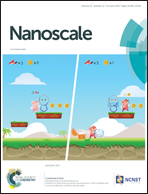Lasing from lead halide perovskite semiconductor microcavity system†
Abstract
Organic–inorganic halide perovskite semiconductors are ideal gain media for fabricating laser and photonic devices due to high absorption, photoluminescence (PL) efficiency and low nonradiative recombination losses. Herein, organic–inorganic halide perovskite CH3NH3PbI3 is embedded in the Fabry–Perot (FP) microcavity, and a wavelength-tunable excitonic lasing with a threshold of 12.9 μJ cm−2 and the spectral coherence of 0.76 nm are realized. The lasing threshold decreases and the spectral coherence enhances as the temperature decreases; these results are ascribed to the suppression of exciton irradiative recombination caused by thermal fluctuation. Moreover, both lasing and light emission below threshold from the perovskite microcavity (PM) system demonstrate a redshift with the decreasing temperature. These results provide a feasible platform based on the PM system for the study of light–matter interaction for quantum optics and the development of optoelectronic devices such as polariton lasers.



 Please wait while we load your content...
Please wait while we load your content...